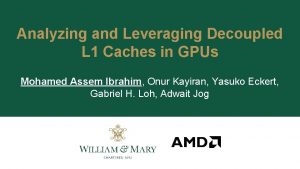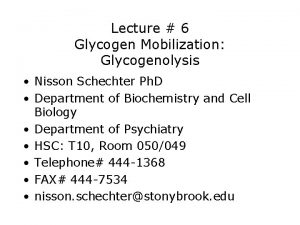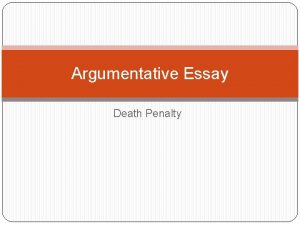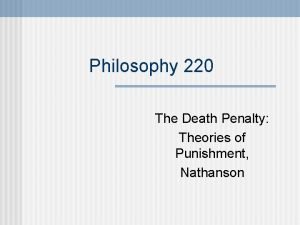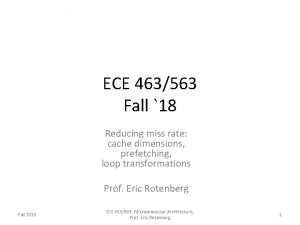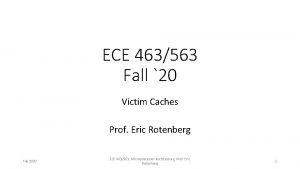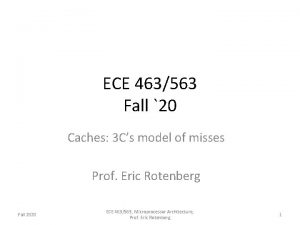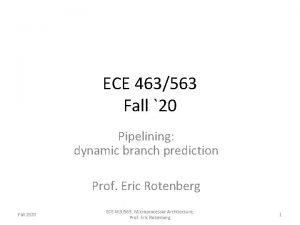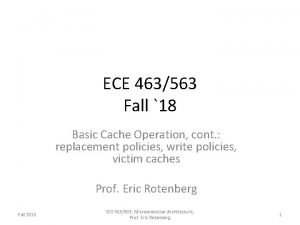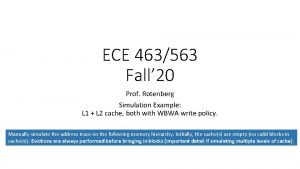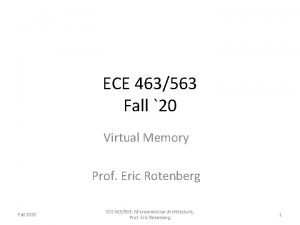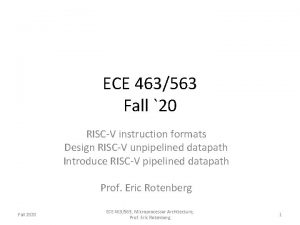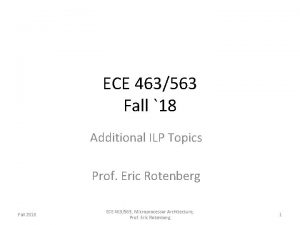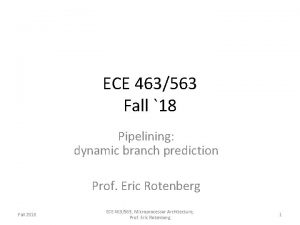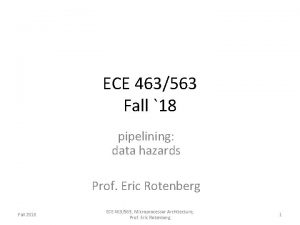ECE 463563 Fall 18 Caches reducing miss penalty













- Slides: 13

ECE 463/563 Fall `18 Caches: reducing miss penalty Prof. Eric Rotenberg Fall 2018 ECE 463/563, Microprocessor Architecture, Prof. Eric Rotenberg 1

Reduce Miss Penalty • • L 2 cache Victim cache Write buffer Early restart, critical word first Fall 2018 ECE 463/563, Microprocessor Architecture, Prof. Eric Rotenberg 2

L 2 cache • Effects of increasing L 1 cache size + Decrease L 1 miss rate − Increase L 1 hit time AAT = HTL 1 + MRL 1* MP • Instead, reduce average miss penalty by “catching” some L 1 capacity misses as hits in a larger cache between L 1 cache and main memory Acronyms: HT: hit time MR: miss rate MP: miss penalty Fall 2018 AAT = HTL 1 + MRL 1 * MPL 1 = HTL 2 + MRL 2 * MPL 2 ECE 463/563, Microprocessor Architecture, Prof. Eric Rotenberg 3

L 2 cache example Example HT MR MP L 1 1 cycle 0. 05 it depends L 2 4 cycles 0. 01 100 cycles L 1 cache only L 1 and L 2 caches MPL 1 100 cycles 5 cycles (4 + 0. 01*100) AAT 6 cycles (1 + 0. 05*100) 1. 25 cycles (1 + 0. 05*5) L 1 cache 4 cycles L 2 cache 100 cycles main memory Fall 2018 100 cycles main memory ECE 463/563, Microprocessor Architecture, Prof. Eric Rotenberg 4

Victim cache • See previous pptx Fall 2018 ECE 463/563, Microprocessor Architecture, Prof. Eric Rotenberg 5

Write misses and the processor • Processor doesn’t need to wait for write miss – It’s not asking for data • Don’t stall processor – Do the write in the background – Need a write buffer – Processor delegates responsibility to the write buffer, for performing the write to the memory hierarchy Fall 2018 ECE 463/563, Microprocessor Architecture, Prof. Eric Rotenberg 6

Write buffer in WBWA Scenario 1: write hit write request from processor write hit L 1 cache WBWA policy Next level in mem. hier. (L 2 cache or main memory) Fall 2018 ECE 463/563, Microprocessor Architecture, Prof. Eric Rotenberg 7

Write buffer in WBWA Scenario 2: write miss write request from processor write miss L 1 cache WBWA policy read block from next level data address merge Next level in mem. hier. (L 2 cache or main memory) Fall 2018 ECE 463/563, Microprocessor Architecture, Prof. Eric Rotenberg 8

Write buffer in WTNA Scenario 1: write hit write request from processor write hit L 1 cache WTNA policy data address write to next level Next level in mem. hier. (L 2 cache or main memory) Fall 2018 ECE 463/563, Microprocessor Architecture, Prof. Eric Rotenberg 9

Write buffer in WTNA Scenario 2: write miss write request from processor write miss L 1 cache WTNA policy data address write to next level Next level in mem. hier. (L 2 cache or main memory) Fall 2018 ECE 463/563, Microprocessor Architecture, Prof. Eric Rotenberg 10

Complication: write followed by dependent read • A read that hits in the cache is ok – Since the block is in the cache, any previous writes to the block have completed • A read that misses in the cache needs special treatment – It must check the write buffer for any pending writes that it depends on – If its address matches a pending write’s address, read gets data directly from write buffer • Otherwise it could get stale data from the next level if the younger read completes before the older write Fall 2018 ECE 463/563, Microprocessor Architecture, Prof. Eric Rotenberg 11

Read miss checks if it depends on any pending writes in the write buffer read request from processor read miss read address L 1 cache (WBWA or WTNA) data address =? =? Next level in mem. hier. (L 2 cache or main memory) Fall 2018 ECE 463/563, Microprocessor Architecture, Prof. Eric Rotenberg 12

Early restart, Critical word first • These techniques shave off a few cycles from the miss penalty by not waiting for all bytes of the block • Early Restart: – As soon as the requested word arrives, forward it to the processor – Processor resumes while the rest of the block is filled into the cache • Early Restart + Critical Word First: – Problem still with Early Restart: What if requested word is in the middle of the block? – Critical Word First: Memory system returns requested word first, followed by other words Fall 2018 ECE 463/563, Microprocessor Architecture, Prof. Eric Rotenberg 13
 Analyzing and leveraging decoupled l1 caches in gpus
Analyzing and leveraging decoupled l1 caches in gpus L caches
L caches Miss penalty della cache
Miss penalty della cache Iodine test reaction for carbohydrates
Iodine test reaction for carbohydrates Reducing sugar vs non reducing sugar
Reducing sugar vs non reducing sugar Bials test
Bials test Glycogen reducing end
Glycogen reducing end Argumentative essay about death penalty
Argumentative essay about death penalty Penalty notice for disorder
Penalty notice for disorder Echr death penalty
Echr death penalty Penalty kill forecheck
Penalty kill forecheck Illegal
Illegal Nnn punishments
Nnn punishments Penalty double in bridge
Penalty double in bridge
